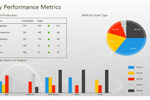Oil and Gas Software and the Accuracy of Decisions
Oil and gas software can be one key to integrated, well structured, well defined IT systems. Data support utilizing an oil and gas specific framework leads to intelligent decision making and a reduction in overhead.
Case study: Oil and Gas Business Intelligence Framework
Data access, forecasting and analysis, reporting and decision making software for dedicated professionals, from the field to the boardroom, are available with solutions developed by Halliburton, Dell, Qualcomm and Microsoft.
 The Oil & Gas Business Intelligence framework, iLink, offers a comprehensive real-time overview of your business. You can track performance metrics that will provide you with the necessary information to make informed business decisions. Dashboards offer an easy to access overview. The process of resource optimization will help to make reliable forecasts based on the most current data. Managers and technicians in the field can communicate data, while tickets and alerts can be created for field personnel.
The Oil & Gas Business Intelligence framework, iLink, offers a comprehensive real-time overview of your business. You can track performance metrics that will provide you with the necessary information to make informed business decisions. Dashboards offer an easy to access overview. The process of resource optimization will help to make reliable forecasts based on the most current data. Managers and technicians in the field can communicate data, while tickets and alerts can be created for field personnel.
iLinks key features are:
· Identifying Key Performance Metrics
· Monitoring Well Performance
· Creating and assigning well issue ticketing and alerts
· Global well map
Microsoft’s partnering with Halliburton has developed the architecture for their oil and gas upstream framework, MURA. This architecture supports business with the goals of gaining maximum insight from business data and maximizing worker productivity. The framework supports real time analytics, including robust statistical and analysis packages for data mining, research and consumer reporting.
It also supports stream-processing engines capable of detecting and filtering real-time events, on site or in the cloud.
Information integration enables diverse data and software to seamlessly function without being trapped in a pipeline to nowhere. Workers need tools that help them gain deeper insights into ever growing quantities of relevant data.
Simplifying the process of finding, selecting, and exploring their data in flexible ways is essential. This process needs to be intuitive for them, and they should not have to rely on IT to fetch data or write custom reports.
You can deliver cost effective solutions with MURA that are highly mobile because of interoperability in the cloud and on-site. MURA supports industry standards. An industry wide interface makes new, competent implementation such as PPDM understandable and manageable.
MURA interfaces are published for open industry use. All the elements of an interface are well defined so that applications can be independently developed once per function. Wasteful duplication of effort can be avoided.
Information models employ a consistent naming system for referring to assets. This makes information sharing, exchange and comprehension an understandable process.
Security implementation is robust and well defined, including authentication, identity lifecycle management, authorization, certificates, claims and threat models. This facilitates secure interoperable design and deployment. Solutions that integrate business processes, workers, workflow and IT processes with essential and immediate data support intelligent workflow.
Business Intelligence in Action
K2 uses MURA to manage declining well process. The MURA framework provides guidance for oil and gas companies for creating a dashboard of applications that are integrated at the user interface layer.
This kind of oversight capability gives well operators the data and context they require be alerted to issues that need timely corrective action. K2 optimizes information provided to decision makers, while minimizing data that is superfluous or in an obscure format. IT departments appreciate MURA and K2 because costs are restrained while business demands are effectively met.
Demand forecasting simplifies and automates enterprise-wide forecasting, and improves the quality and measurability of marketing planning. When you improve accuracy significantly, it is likely to result in improved capital decisions and effective communication that will ultimately bring a reduction in overhead and operating costs.
For more on how oil and gas software can help your business, read this post on the benefits of analytics.
